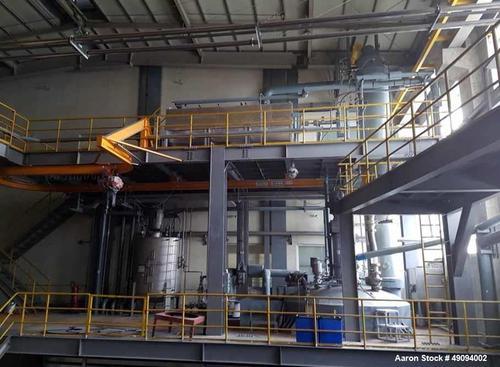Chemical Plant Polymerization Reactor
Polymerization is a process of reacting monomer molecules together in a chemical reaction to form polymer chains. There are many forms of polymerization such as condensation polymer, addition polymer and copolymerization. Abster Polymerization System is used for various polymerizations and performs accurate process.
Fixed bed reactor introduction
- 1. Operating principle: Break down or recombined the materials through mixing, filling, heating and cooling, to promote the reaction of polymerization.
- 2. Components: Body, gears, mixing devices, heating devices, cooling devices, seal, etc.
- 3. Auxiliary Equipment: Distillation column, head tank, condenser, water separator, collecting cans, filters, etc.
General efficiency of the equipment
- 1. The equipment can perform material heating and cooling according to process requirements. The heating method can completely meet actual requirements, such as steam and electric heating methods.
- 2. The equipment also has various stirring types which can completely meet actual reaction and stirring requirements.
- 3. The tank body and pipes have gone through mirror polishing treatment which makes it more adaptable for reaction of viscous materials.
- 4. Double stirred reactor can be equipped with vacuum pump which enables vacuum bubble pumping.
- 5. The equipment can also be equipped with spreading head of bottom-installation type or emulsifying head of pipeline type which can enable quick decomposition and reaction of the materials.
- 6. The controller of the equipment can monitor the operation of the whole equipment, it can also clearly display reaction temperature and rotation speed for stirring, etc.
Classification of Polymerization
Condensation Polymerization
Condensation polymerization releasing small molecules as by-products such as water or methanol. Because this reaction resulting loss of small molecules which is often water, it’s also called dehydration polymerization. Concentrated Sulfuric Acid is used to process to accelerate reaction. Peptide binding and Ester binding is a typical example of condensation polymerization.
Ex) polyamide, polyester, urethane, bakelite
Ex) PVC, polyethylene, polystyrene
| Pros | Cons | Examples | |
| Bulk Polymerization |
Simple process and derives macromolecules with high purity | Hart to control exothermicity and high viscosity occurs. | -Continuous polymerization of styrene.
- Casting of methacrylate plate - Continuous polymerization of polyvinyl |
| Suspension Polymerization |
Easy heat dissipation and derives macromolecules with low viscosity available as it is. | This reaction needs cleaning and dehydration. Polymer cogulation can occur, and purity of polymer is getting low due to pollution by addictive. | - Adhesives made from polyvinyl acetate
- Rubber made from polypropylene and polybutadiene. |
| Solution Polymerization |
Easy heat dissipation and derives macromolecules with low viscosity available in solution. | The solvent for reaction is expensive, hard to remove solvent completely, and chain transfer reaction with solvent can occur. | Beads, pvc powder made from foamed polyethylene, polystyrene, PMMS. |
| Emulsion Polymerization |
Easy heat dissipation and derives macromolecules with low viscosity available in emulsion. This is suitable for mucoadhesive polymers. | Purity of polymer is getting low due to emulsifier and other addictives | - Polyvinyl, polyvinyl acetate, polystyrene
- Resin finishing agent for SBR, NBR, concrete |
Design and manufacture according to KGS and KOSHA.
Maintain constant temperature by internal/external insulation
Improve safety through the multi-safety devices
Different types of research are available by various additional components.
Easy assembly/disassembly and clean up
Quick response to customer request by customer service team.
Reaction Vessel, Jacketed Reaction Vessel, Limpet Coil Reaction Vessel, Stainless Steel Reaction Vessel manufacturer and supplier India
Products
- Chemical Plant Polymerization Reactor
- Chemical Reaction Vessels
- Resin Reactors
- Stainless Steel Unsaturated Polyester Resin Reactor
- Stainless Steel Reaction Kettle Design
- Polyester Resin Reactor
- Tray Dryer Manufacturer in Ahmedabad
- Tray Dryer
- Tray Dryer GMP Model
- Softgel Capsule Manufacturing Equipments
- Gelatin Cooking Mixer Manufacturer
- Gelatin Holding Tank
- Reaction Vessel
- V Cone Blender Mixer
- Condenser / Heat Exchanger
- Pressure Vessels
- Distillation Unit
- Pilot Reaction Unit
- Sigma Mixer
- Ribbon Blender
- Tray Dryer Machine
- Tray Dryer manufacturer
- Tray Dryer GMP Model
- Tray Dryer manufacturer In Ahmedabad
- Horizontal Autoclave
- Cylindrical Autoclave
- Drum Flaker
- Attritor
- Twin Shaft Disperser
- Triple Roll Mill / Three Roll Mill
- Pharmaceutical Octagonal Blender
- Pharmaceutical Ribbon Blender
- Reaction Vessel Exporter in India
- sigma mixer manufacturer

